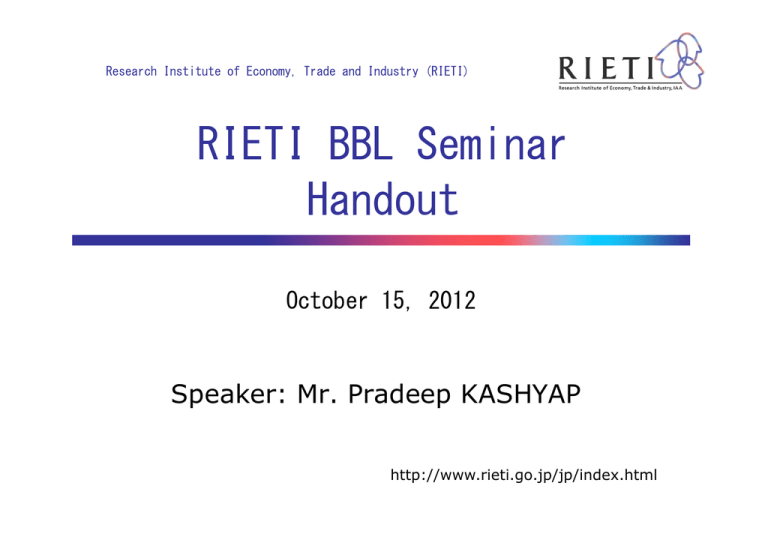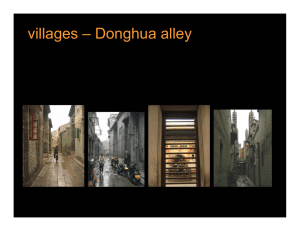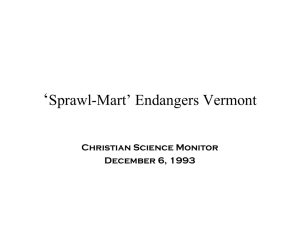RIETI BBL Seminar Handout Speaker: Mr. Pradeep KASHYAP October 15, 2012
advertisement

Research Institute of Economy, Trade and Industry (RIETI) RIETI BBL Seminar Handout October 15, 2012 Speaker: Mr. Pradeep KASHYAP http://www.rieti.go.jp/jp/index.html The Emerging Market India Presentation to RIETI, Japan October 15, 2012 1 Challenges of Doing Business in India 2 Understanding Diversity … A Snapshot 21 official languages, 432 dialects 4 major religions 56 Socio Cultural Regions Literacy Per Capita Income (USD per annum) Kerala 93% Goa 3700 Bihar 63% Bihar 470 Source : Census of India 2011,, Directorate of Economics & Statistics 2012 ,MART Knowledge centre (c)MART 3 Where Does India Live Population GDP share 50 large cities 25% 12 % Large Cities 8,000 towns 25% 50% 18% Small Towns 70 % 1 Million + < 1 Million < 10,000 Villages (640,000) Source : Census of India 2011,, India Urbanization Econometric Model ‐McKinsey Global Institute ,MART Knowledge centre 4 Tale of Three India's…Where to go J&K INDIA 1 2 3 TV ownership(%) 50 25 12 4 wheeler ownership (%) 4 1.5 0.9 GDP Share (%) 30 34 36 Population (%) 20 30 50 Punjab HP Haryana Rajasthan UP Bihar Gujarat Jharkhand WB Chattisgarh Maharashtra Orissa MP AP Source : Max NCAER Survey, 2007 and IRS 2011 Karnataka Kerala TN TN 5 Why to Invest in India? Economy : USD 2 trillion (USD 10 trillion in PPP) Last decade GDP growth : 8% Demographic dividend …Youngest nation Average Age India US Japan 25 36 43 360% Rise in consumer spending in next 10 years Global Innovation Hub…2nd largest technical workforce Source : The Tiger Roars BCG report & MART Knowledge Centre, & 12th Five Year Plan, GoI, 6 Income Pyramid Morphing to Diamond 2010 Per capita Income per day (USD) 2020 70 > 4 170 530 600 1‐4 < 1 800 375 Population 1200 1350 (million) Annual HH 6,393 Income (USD 3 x Source : The Tiger Roars BCG report & MART Knowledge Centre 18,448 7 How to Localize Business (c)MART 8 Success : McDonald’s Meticulous Planning Reliable supply chain built from Farm to Fork over 6 years Culturally Sensitive No‐Beef , No‐ Pork Food Physical separation of Vegetarian items from farm to customer Indianized Menu McAloo Burger (Potato), Mc Veggie, McEgg Pricing Highly affordable, starting 40 cents – PPP basis Promotion Innovative Practice Family dinning for Indian tradition Home Delivery . 250 outlets in India…40% share in fast food market …planning to have 500 outlets in next three years 9 Failure : Kellogg’s India Opportunity Entry Cultural Barriers Price Outcome Product Price Promotion 250 Middle class completely untapped market 1994, investment of 65 million$, Corn Flakes brand Eating breakfast cereals new concept Indians prefer different breakfast types every day Indians have all hot meals, also hot milk for breakfast (Corn flakes remains crisp in cold milk) International pricing. 3 times of local brand (Too expensive) Very low sale. Kellogg’s launched its other products – Choco Puffs, Honey Crunch…No success Reasons for Failure Western product, but local tastes very strong Too high Advertising hinted Indian breakfast not nutritious, hurt local sentiments 10 How to localize Business in India…Learning’s Understand local ecosystem Hire local talent Partner local companies Understand local consumer behavior and customize products Set up R & D facility Benchmark price and quality against local players 11 12 Project Shakti – Women’s Empowerment Co‐created by Hindustan Unilever & MART 2000‐2005 13 Where does Rural India Live No of villages 22 % 20,000 32% 90,000 25% 140,000 390,000 Village population Population % 21% Large >5000 Medium Villages 2001‐5000 Small villages 1000‐2000 Very small Villages < 1000 Source : Census of India 2001,MART Knowledge centre 14 HUL Rural Coverage Strategy High Indirect Coverage 5000+ pop villages Accessibility Combined IDC Shakti Low 1000 – 2000 pop villages Low Project Shakti – Women's Empowerment Turnover / market (c)MART Streamline 2000 – 5000 pop villages High 15 The Genesis Need Penetration in <2000 pop villages HUL + SHG Win – win partnership Sustainable business opportunity Shakti ‐ The Model HUL Distributor Doubles Family Income Supply Shakti Entrepreneur Payment Sells Consumers Monthly Sale Net Profit $ 300 – 500 $ 25 – 35 Retailers Current Status Scalability & Sustainability of Model • 50,000 Shakti Entrepreneurs appointed across India • 100,000 villages covered • 10 million consumers serviced Project Shakti – Women's Empowerment Win‐Win Model for All Bank * Provide gainful livelihoods to the poor * Non grant sustainable livelihood Project Shakti * Sustainable income opportunity * Learn business Skills * Economic Empowerment * Education / Awareness * Better product reach * Low cost communication channel * Category penetration * Social fulfillment HUL 20 Woman Government * Higher loan offtake * Better repayment * Social fulfillment Win‐Win BOP Healthcare Model Co‐created by MART Lessons Learnt…The Way • • • • • A Win – Win for all stakeholders Buy in from the top management Use of existing social infrastructure Need for facilitating organization (MART) Developing capacities of local partners 23 Future Potential of India Future Growth Path Growth Target 12th five year plan 8.2% Dominant services sector expanding to retail, health, financial services and tourism 5th largest economy by 2025 (USD 10 trillion) Innovation Hub 25% GDP share from manufacturing by 2022 from 16% at present…doubling employment Transport & logistics – USD 114 bn by 2014 at 10% CAGR Universalization of secondary education by 2017 Health expenditure to reach 2.5 % of GDP by 2017… Healthcare to become USD 170 billion market by 2025 Role of a foreign company 25 Environmental Sustainability : P & G Insight Program Contribution Employees Insight Consumers want to support top need of Education of poor children Supported 140 schools in partnership with social organization INR 220 million by employees, stakeholders, celebrities, thought leaders Volunteer time and effort Consumers want to support top need of Education of poor children 26 Role of Foreign company Support Inclusive Growth Connect with local community Develop efficient solutions 27 Coca Cola India’s Engagement With Sustainability Programs: Water Improving quality of life Coca‐Cola in India works with local organizations, governments and NGOs to support projects most relevant to community needs. Water Reduce Recycle Replenish Water is most important ingredient in beverages. It is also used for rinsing, cleaning, heating and cooling. Coca‐Cola in India has improved its water use efficiency by over 25 percent since 2005 Wastewater is recycled through a treatment and cleansing process. Coca‐Cola works on Water replenishment projects that support communities and nature ‐ rainwater harvesting structures, construction of check dams, restoration of ponds and traditional water bodies. They have installed 400 rainwater harvesting 28 structures across 22 states Thank You 29





